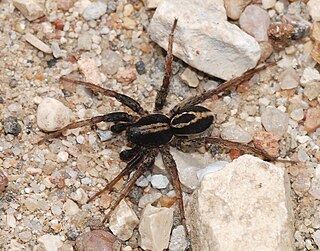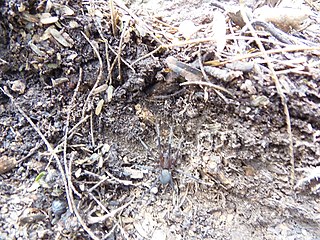Related Research Articles

Tengellidae is a former family of spiders that has been merged into the family Zoropsidae. Genera formerly placed in Tengellidae now in Zoropsidae include:

Zoropsidae, also known as false wolf spiders for their physical similarity to wolf spiders, is a family of cribellate araneomorph spiders first described by Philipp Bertkau in 1882. They can be distinguished from wolf spiders by their two rows of eyes that are more equal in size than those of Lycosidae.

Cybaeidae is a family of spiders first described by Nathan Banks in 1892. The diving bell spider or water spider Argyroneta aquatica was previously included in this family, but is now in the family Dictynidae.

Lycosoidea is a clade or superfamily of araneomorph spiders. The traditional circumscription was based on a feature of the eyes. The tapetum is a reflective layer at the back of the eye, thought to increase sensitivity in low light levels. Lycosoids were then defined by having a "grate-shaped" tapetum. Research from the late 1990s onwards suggests that this feature has evolved more than once, possibly as many as five times, so that the original Lycosoidea is paraphyletic. Studies published in 2014 and 2015 suggest that a smaller group of families does form a clade.

The RTA clade is a clade of araneomorph spiders, united by the possession of a retrolateral tibial apophysis – a backward-facing projection on the tibia of the male pedipalp. The clade contains over 21,000 species, almost half the current total of about 46,000 known species of spider. Most of the members of the clade are wanderers and do not build webs. Despite making up approximately half of all modern spider diversity, there are no unambiguous records of the group from the Mesozoic and molecular clock evidence suggests that the group began to diversify during the Late Cretaceous.

Udubidae is a family of araneomorph spiders, most of whose members were formerly placed in the family Zorocratidae, which is no longer accepted.
Zorodictyna is a genus of spiders in the family Udubidae native to Madagascar. It has been described as an intermediate genus between Zoropsidae and Dictynidae, though it is now placed in Udubidae. This genus was originally placed in the family Zoropsidae, but it has been reassigned several times since. In 1967, Lehtinen moved it to Miturgidae. In 1999, it was moved back to Zoropsidae, and in 2015, it was moved to Udubidae.
Campostichomma is a genus of spiders in the family Udubidae native to Sri Lanka. Many of its species were moved to either Griswoldia or Devendra. This genus was originally placed in the family Agelenidae. It was moved to Miturgidae in 1967, to Zoropsidae in 1999, then to Udubidae in 2015.
Devendra is a genus of Asian false wolf spiders first described by Pekka T. Lehtinen in 1967.
Lauricius is a genus of North American false wolf spiders that was first described by Eugène Louis Simon in 1888. As of September 2019 it contains two species, found in the United States and Mexico: L. hemicloeinus and L. hooki. Originally placed with the sac spiders, it was transferred to the Zoropsidae in 1967.
Liocranoides is a genus of American false wolf spiders that was first described by Eugen von Keyserling in 1881. They live in habitats with cold surfaces, such as caves. It was transferred from the sac spiders to the Tengellidae in 1967, which was later merged with Zoropsidae.

Zorocrates is a genus of spiders in the family Zoropsidae. It was first described in 1888 by Simon. As of 2017, it contains 31 species.
Griswoldia is a genus of spiders in the family Zoropsidae. It was first described in 1997 by Dippenaar-Schoeman & Jocqué. As of 2017, it contains 12 species, all found in South Africa.
Itatiaya is a genus of spiders in the family Zoropsidae. It was first described in 1915 by Mello-Leitão. As of 2017, it contains 8 species, all found in Brazil.
Phanotea is a genus of spiders in the family Zoropsidae. It was first described in 1896 by Simon. As of 2017, it contains 13 species, all from South Africa.
Vulsor is a genus of araneomorph spiders in the family Viridasiidae, first described by Eugène Simon in 1889. Originally placed with the wandering spiders, it was moved to the Viridasiidae in 2015.
Chinja is a genus of Tanzanian araneomorph spiders in the family Zoropsidae, first described by D. Polotow & C. Griswold in 2018. As of April 2019 it contains only two species.
Raecius is a genus of African araneomorph spiders in the family Udubidae, first described by Eugène Simon in 1892.
References
- ↑ Polotow, Daniele; Carmichael, Anthea & Griswold, Charles E. (2015), "Total evidence analysis of the phylogenetic relationships of Lycosoidea spiders (Araneae, Entelegynae)", Invertebrate Systematics, 29 (2): 124–163, doi: 10.1071/IS14041
- ↑ "Family: Udubidae Griswold & Polotow, 2015", World Spider Catalog, Natural History Museum Bern, retrieved 2015-11-06
- ↑ "Gen. Zorocrates Simon, 1888", World Spider Catalog, Natural History Museum Bern, retrieved 2015-11-06
| | This article related to araneomorph spiders is a stub. You can help Wikipedia by expanding it. |